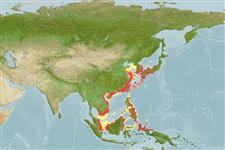Environment: milieu / climate zone / depth range / distribution range
Ecology
Marine; brackish; pelagic-neritic; depth range 5 - ? m (Ref. 12166). Tropical; 39°N - 1°S, 103°E - 138°E (Ref. 54449)
Indo-Pacific: Indian Ocean (Kuwait Bay and Pondicherry), Java Sea (Singapore), East China Sea (Canton north to the Koreas and southern Japan, as far as Osaka on the Pacific coast and Fukuoka in Sea of Japan, also Peter the Great Bay in Soviet waters).
Size / Weight / Age
Maturity: Lm ? range ? - ? cm
Max length : 60.0 cm TL male/unsexed; (Ref. 56557); common length : 30.0 cm TL male/unsexed; (Ref. 27773); max. published weight: 140.00 g (Ref. 4883)
Dorsal spines (total): 0; Anal spines: 0; Anal soft rays: 43 - 53. Body slender, belly with usually 24 to 25 + 10 to 15, total 34 to 42 scutes. Eye large, lower jaw projecting. Dorsal fin origin at about midpoint of body or a little behind; anal fin origin a little behind dorsal fin base. Swim bladder with a long tube passing back down right side of body above anal fin base.
Found inshore, entering estuaries and presumably able to tolerate lowered salinities; also found in semi-enclosed sea areas (Ref. 11230). A warm-water species that does not reach the northern part of its range in cool years. Used in Chinese medicine (Ref. 12166).
Whitehead, P.J.P., 1985. FAO Species Catalogue. Vol. 7. Clupeoid fishes of the world (suborder Clupeoidei). An annotated and illustrated catalogue of the herrings, sardines, pilchards, sprats, shads, anchovies and wolf-herrings. FAO Fish. Synop. 125(7/1):1-303. Rome: FAO. (Ref. 188)
IUCN Red List Status (Ref. 130435)
Threat to humans
Harmless
Human uses
Fisheries: highly commercial
Tools
Special reports
Download XML
Internet sources
Estimates based on models
Preferred temperature (Ref.
123201): 17.6 - 29, mean 27.9 °C (based on 396 cells).
Phylogenetic diversity index (Ref.
82804): PD
50 = 0.5000 [Uniqueness, from 0.5 = low to 2.0 = high].
Bayesian length-weight: a=0.00676 (0.00437 - 0.01045), b=3.02 (2.90 - 3.14), in cm total length, based on LWR estimates for this species & Genus-body shape (Ref.
93245).
Trophic level (Ref.
69278): 3.8 ±0.61 se; based on food items.
Resilience (Ref.
120179): Medium, minimum population doubling time 1.4 - 4.4 years (tm=2; Tmax=6-7; K=0.2-0.4).
Prior r = 0.88, 95% CL = 0.58 - 1.32, Based on 4 data-limited stock assessments.
Fishing Vulnerability (Ref.
59153): Low to moderate vulnerability (34 of 100).
Climate Vulnerability (Ref.
125649): Moderate vulnerability (38 of 100).
Nutrients (Ref.
124155): Calcium = 104 [61, 212] mg/100g; Iron = 1.41 [0.84, 2.22] mg/100g; Protein = 19.5 [18.1, 20.8] %; Omega3 = 0.364 [0.193, 0.671] g/100g; Selenium = 44.5 [22.8, 87.2] μg/100g; VitaminA = 21.5 [8.1, 52.5] μg/100g; Zinc = 1.15 [0.82, 1.60] mg/100g (wet weight); based on
nutrient studies.
